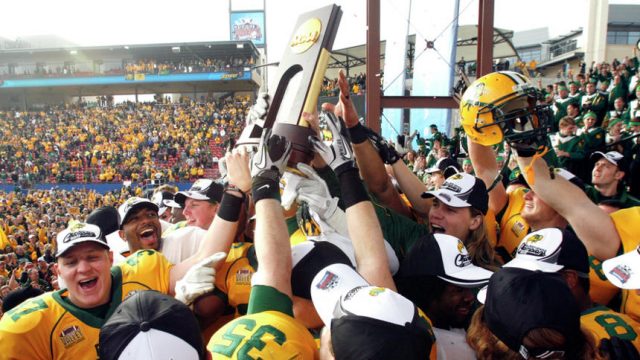Where’s the Evidence That Football Championships Boost Campus Enrollment?

North Dakota State University football players celebrate their win over Sam Houston State during the FCS title game at FC Dallas Stadium in Frisco, Texas on Saturday, January 7, 2012. Carrie Snyder / The Forum
 Collegiate sports at most universities – including North Dakota’s two largest campuses, UND and NDSU in Grand Forks and Fargo respectively – do not make money. In fact, they cost taxpayers and students quite a bit of money.
Collegiate sports at most universities – including North Dakota’s two largest campuses, UND and NDSU in Grand Forks and Fargo respectively – do not make money. In fact, they cost taxpayers and students quite a bit of money.
Not even the top-tier teams, which would be the men’s hockey team at UND and the men’s football team at NDSU, generate more revenue than they cost. According to a 2017 report from sports writer Jeff Kolpack every single sports team at NDSU and UND ran a deficit in 2016 even after accounting for things like alumni donations, ticket sales, concessions, and merchandise revenues.
Collegiate sports fans like to justify sports teams with a lot of talk about the fiscal benefits high-profile sports teams bring to their campuses. But that’s mythology.
In truth, sports are an expense.
Yet even when that reality pierces the defenses of sports program defenders they turn to other supposed benefits. Such as the notoriety sports teams bring to schools, particularly championship teams. “It attracts your future students,” UND President Mark Kennedy told the Grand Forks Herald last year when questioned about my criticism of the cost of sports programs. He called sports the “front porch” of the university.
Where’s the evidence that this is true?
The recent success of the NDSU football team gives us a particularly good example of just how bogus this example is.
From 2011 to 2017 the NDSU men’s football team has had about as much success as they could possibly have. They won Division I FCS national championships in six of those seven years.
Despite all that success, fall enrollment at NDSU has actually gone down slightly from 14,399 students to 14,358.
Here’s a chart showing the trend line, and here’s the data I used as my source.
Meanwhile, news from NDSU is that despite the latest national championship last year enrollment is expected to decline more this fall: “North Dakota State University is facing a possible enrollment drop in the range of 300 students as it approaches the fall semester — a decline that could come with significant budgetary consequences,” my colleague Patrick Springer reports.
The “budget consequences” are due to a state funding formula which bases a university funding, in part, on enrollment. Fewer students, logically, means less money.
Some might be tempted to argue that the drop in enrollment at NDSU is the Legislature’s fault. Certainly university leadership likes to cast aspersions, sometimes not so subtly, at the state’s political leadership over funding issues. That argument also doesn’t pass muster when we compare it to the data:
Certainly North Dakota’s university system has seen budget cuts over the last couple of biennia, but those cuts are coming after what were in hindsight unsustainable increases in spending.
From 2011 to 2015 the funding for North Dakota’s university spiked, and the NDSU football team won four back-to-back national championships, yet enrollment both for the university system as as whole and for NDSU specifically was stagnant.
I’m not defending the Legislature’s approach to budgeting for higher education. This boom-bust cycle we’ve seen hasn’t been good for the universities at all. The lawmakers didn’t say “no” enough back when an oil boom was pumping a tidal wave of revenues into state coffers, and once those revenues went away they had to make painful but entirely necessary corrections.
But this argument that collegiate sports are some great boon for North Dakota’s universities is bogus. They’re not, based on the data.
UPDATE: I goofed on the NDSU championships saying they’d won six straight. It was actually six in seven years from 2011 to 2017. I’ve edited the post to fix that error.






